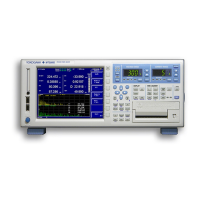11-3
IM WT3001E-51EN
FFT (Option)
11
• FFT Function
The power spectrum can be derived from the equations below.
• Voltage, Current, and Power
The complex function of the voltage after taking the FFT is assumed to be U = Ur +
jUj, and that of the current is assumed to be I = Ir + jIj.
Ur
2
+Uj
2
2
Power spectrum of voltage =
Power spectrum of current =
Power spectrum of active power =
UrIr+UjIj
Power spectrum of reactive power =
UrIr–UjI
r
r
j
j
Ir
2
+Ij
2
2
• Torque and Speed
The complex function of the torque signal after taking the FFT is assumed to be T =
Tr + jTj, and that of the speed signal is assumed to be S = Sr + jSj.
Tr
2
+Tj
2
2
Power spectrum of torque =
Power spectrum of speed =
T
r
r
j
j
Sr
2
+Sj
2
2
• Differences between the Harmonic Measurement and FFT on this
instrument
In harmonic measurement, the source signal is sampled at a sample rate that is in
sync with the PLL source, and component signals that are integer multiples of the
fundamental wave are measured. Therefore, harmonic measurement is suited to
measuring signals that include only the harmonics that are integer multiples of the
fundamental wave and can be used determine the impedance of each harmonic order
or the total of all harmonics.
In FFT, the source signal is sampled at a fixed sample rate, and Fast Fourier transform
is taken on the bandwidth up to a half of the sampling rate. Therefore, it is suited to
analyzing signals that include components (distorted waveform and noise) that are not
integer multiples of the fundamental wave.
• Limitations on the Function and Measurement Function
FFT mode performs internal computation differently from other measurement
modes. Therefore, some functions such as trend and bar graph displays on the
screen, integration, and storage function cannot be used in this measurement
mode. In addition, some measurement functions such as harmonic measurement
and impedance cannot be carried out. For a list of functions with limitations and
measurement functions that cannot be measured, see appendix 10 and 11 in the
User’s Manual IM WT3001E-01EN.
Note
In FFT mode, TYPE 3 cannot be selected for the equation of the apparent or reactive power. If
TYPE3 is selected and you select FFT mode, the equation switches to TYPE1. For details on
the type of equations, see section 2.5 and 5.9 in the User’s Manual IM WT3001E-01EN.
• Rms Values of Voltage U and Current I
The rms values of the voltage U and current I that are measured in the FFT mode are
normal measured values. For details on the normal measured value, see “Relationship
between the Rms Values of Voltage U/Current I and Measurement Modes” in section 7.1.
11.1 FFT Function

